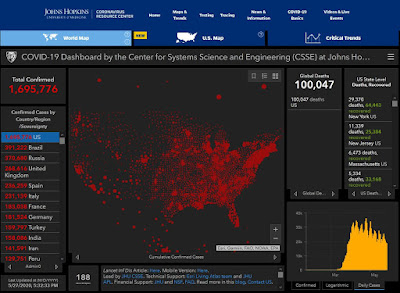Parsing Out Dystopia: Passing 100,000 Dead
 |
| May 27. |
The consensus seems to be that a second wave will come in the fall when cooler weather returns. But no one knows for sure. Dr. Anthony Fauci reads the data and changes his opinion as the data changes. In April he warned of a second wave. Now, he says it is "not inevitable." We'll see which version of himself is correct.
The World Health Organization firmly believes this is only the "first wave." Whether it is or isn't, we are likely going to have to learn to live with it to some extent. I can't imagine what this Christmas is going to be like (or even the November election) if a second wave of this thing hits us.
Some 5.6 million people have caught the virus out of 7 billion on the planet. That is 0.0008% of the world's population. The best that can be said is that we have done a great job of containing the virus so far. A total of 356,000 deaths worldwide are currently attributed to COVID-19. As of this post, the percentage of deaths to the global population is microscopic.
But we wrecked the global economy in the process. I think it is safe to say that never before has so much economic carnage resulted from so few deaths. This is, perhaps, the weakest "pandemic" ever. Should we count ourselves lucky or did we over-react?
We should remember, however, that these things have a long residual history when they pass their peaks. The 1968 Hong Kong Flu pandemic killed between 1 - 4 million people worldwide over about 20 months. And it is still around today as a strain of the seasonal flu. COVID-19 probably won't ever completely go away, even if there is no "second wave."
We never developed a vaccine for the 1968 pandemic.
There were widespread reports of people gathering in large numbers and not observing social distancing over the Memorial Day weekend. Personally, if we don't see a rise in the US numbers within the next two weeks then, like Easter and Mother's Day, it would seem that social distancing is not that big of a deal. My opinion will be based on the numbers. Everything else is just some kind of spin.
Here are some samples of daily death rates on the Johns Hopkins University website today. Keep in mind the scales are different for each country, but this does give you some idea about general trends.
 |
| Deaths in the United States are on a steady downward trajectory. |
 |
| Russia seems to have passed its peak. |
 |
| Iran has already experienced a second wave. |
 |
| Momentum is building in Brazil, the world's largest "hot spot" as of this post. |
 |
| Deaths in Mexico are rising. |

Comments